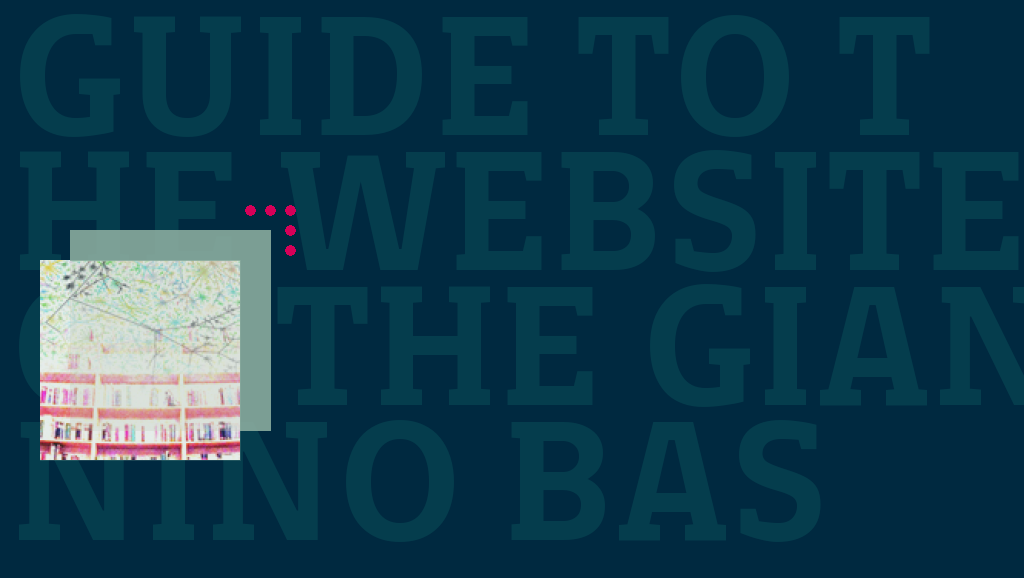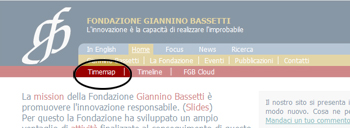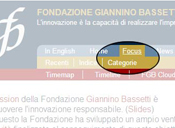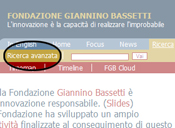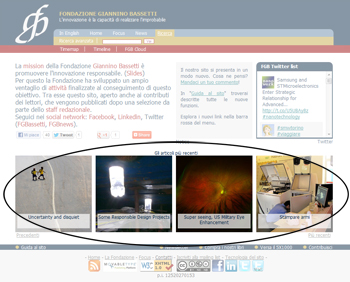In 2012 the Bassetti Foundation launched its new website, a site that hopes to address the three principal issues propagated by the web: the new and ever developing navigation techniques used by our regular readership (blogging, social networking, interaction and exchange); the need to valorize and make the enormous quantity of material that has been put online since the launch of the site in 2000 visible; the wish to confront the problem of orientation and historical contextualization posed by the exponential growth of information on the web.
The major new functions of the site can be found in the red menu bar at the top of the screen, but these are not the only new features of the redesigned graphics.
Timemap
The Timemap is a map of the site that prevents the user from getting lost, to understand at a glance that over more than ten years of presence there have been different and stratified interpretations of the web format, and therefore to contextualize the pages visited. The web often offers articles that are difficult to date. We however would like an understanding of a text that has been written at a precise moment to include its predictive aspects, as well as those current and those tied to a specific historical moment. The form of the map is arbitrary, but allows the user to move through the various areas of the site and quickly understand both their content and their historical position.
Timeline
Again with a view to making finding and understanding materials in context easy, we have developed a timeline that allows the user to quickly see how articles are placed historically.
With the timeline users can quickly access the most recently published articles, read an outline even before going to the page, and identify them through images that characterize them (to see if any articles have been missed). The filters placed above the timeline allow a search by author and category, or to go quickly to a particular year of publication. Every search shows its results in thin light blue bars within the grey bar.
With a further reading the timeline also allows a view of Foundation activities, for example in which period a precise argument was mainly addressed, or simply which areas have been explored the most.
FGB Cloud
We could have called it Cloudmap but the names would start to become confusing. The cloud that we speak about is a cloud identity, as our online presence is distributed between the website, social networks, linked sites, deposits of materials etc. Through the FGB cloud the readership has an overall vision of our online presence, the purely numerical impact and obviously the chance to go directly to the remote pages.
The numbers in the windows are adjourned every week or whenever there are notable changes.
Research modes
The Timemap, Timeline and FGB Cloud also represent three ways to search the site. They obviously sit aside the more traditional ways: the new index by category and author are also available through ‘Focus’ and ‘Search’ in the gold and blue menu. The Research button allows both a fast search and the possibility of going to an advanced page where different filters can be applied.
Dedicated fields on the Home page
The new graphics have a specific intent, that of providing the best service to the different types of visitor. We wanted to make access easier for three large categories. Those who visit for the first time or want to have more information about the Bassetti Foundation (blue), those who already know the site and the Foundation and wish to read the new articles (green) and those who use the web for exchange of information and like to intervene, share and interact (red). The home page therefore works to direct visitors to the part of the site that most responds to their individual motivations for coming to our pages, without ever closing off the possibility of visiting the rest of the site.
Sitography
Understanding that many of our visitors wish to print or download site content, since 2007 we have been working on the problem of making the hidden links in the text visible. We have developed a technique that allows the links to remain, but to be displayed as notes on the bottom of each printed page.
In this new edition of the site we want to better display interconnectivity, so the reader can see a schematic representation of the sitography if desired, (as well as the ‘title’ tag that appears when the mouse is passed over the link), to better understand already available connections and links to any article.
Carousel
This section is dedicated to the user who already knows the site and frequents it for the articles we publish. We want to move towards article identification through images and at the same time give access to articles that are no longer recent but neither not yet old. The "carousel", is the instrument that circulates the images, allowing a viewing experience that is even simpler than scrolling down the page. Perception is not lost, other resources on the page can be reached at any moment, and a good understanding of the temporal development of the publications is maintained.
Twitter
The portion dedicated to Twitter is created from a list of authors selected and filtered through key words and "ashtag" (short tags that allow a user to join Twitter on the same argument). It is a window to the outside world that allows the giving and receiving of information that would otherwise not be reached. Would you like to be on the list? Send us your Twitter account credentials and we will check them out.
